

Felipe Pimenta was stuck. A doctoral student in oceanography at the University of Delaware, he had to complete a final project for his offshore wind power class. His department required him to take an elective course outside his field of study, and he had settled on the wind power class because his mentor, Richard Garvine, was one of three professors teaching it in the spring of 2005. Now, he was faced with the final project: assessing the feasibility of an offshore wind farm southeast of Brazil.
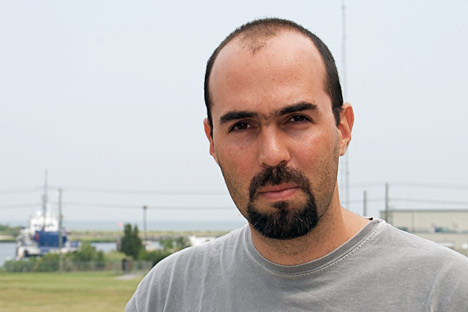
Felipe Pimenta used NASA satellite data to estimate the potential for wind power generation off the Brazilian coast. (Photograph ©2008 by Felipe Pimenta.)
Settling on a topic for the project had not been difficult. A native Brazilian, Pimenta was attending the University of Delaware on a scholarship from the Brazilian government. He wanted to do something that could help his country, and he knew that finding new sources of electricity was a high priority in Brazil. A country that hosts both the world’s largest rainforest and the world’s largest river by volume, Brazil relied almost entirely on hydropower. Pimenta recalled the threat of blackouts in 2001 when the country’s reservoirs dropped to dangerously low levels after years of drought. When water levels in reservoirs behind the hydroelectric dams dropped, the country nearly halted, he says. After the electricity crisis, Brazil launched an effort to diversify its power supply. Because it is comparable in cost to fossil fuel power plants, Pimenta thought offshore wind power might be a good option.
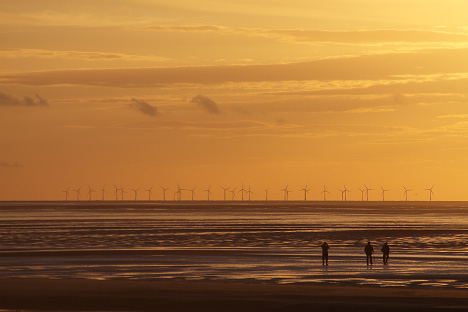
Offshore wind power is a relatively untapped source of clean and renewable energy. (Photograph ©2007 by MrPhilDog.)
“I knew that winds were pretty strong in southern Brazil. That’s where I lived,” says Pimenta. Winds tend to be strongest over flat regions like large plains or the ocean, where no mountains or other surfaces impede their movement. Offshore wind farms are more expensive to install than onshore ones, but offshore locations have greater potential for accommodating large projects. Further, highly populated regions, where power is needed most, tend to be near the coast, both in Brazil and throughout the rest of the world. Brazil has a number of wind projects under development, but all are land based. “I don’t think people have really looked or thought about the magnitude of the resource that is available offshore,” says Pimenta. “The region is very close to populated centers of the country.”
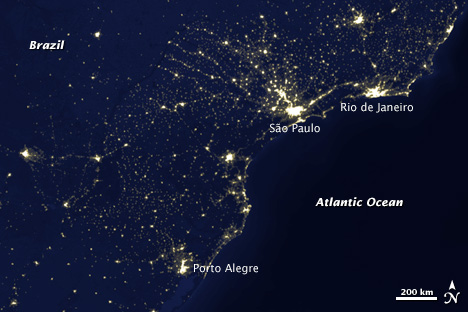
This satellite map of city lights shows the dense populations along Brazil’s southeast coast. The brightly lit cities of Rio de Janeiro, São Paulo, and Porto Alegre stand out most prominently. (NASA image by Robert Simmon, based on MODIS Blue Marble and Defense Meteorological Satellite Program city lights data.)
So, the topic had been easy. The problem was finding data to support his hunch that offshore wind had great potential in Brazil. To determine how much wind energy can be generated over coastal waters, Willett Kempton and Richard Garvine (who taught the technical and scientific aspects of Pimenta’s class) had shown their students how to estimate wind speeds 80 to 100 meters off the surface of the ocean, where a turbine’s massive blades would spin. Starting with wind speeds recorded by meteorological buoys near the ocean’s surface, students extrapolated wind speeds using a mathematical equation that describes winds at different heights in the atmosphere.
From there, he intended to calculate how much energy could be produced with a General Electric 3.6s Offshore turbine and the REpower Systems 5M turbine. The companies had released detailed information about the amount of power each type of turbine would produce at a variety of wind speeds. To estimate how much electricity Brazil could expect to generate using existing technology, he just had to know the wind speed.

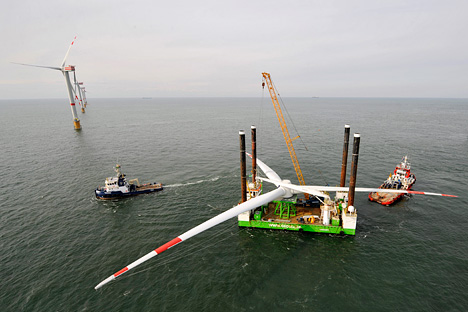
Pimenta calculated the energy-generating potential of the GE 3.6s (top) and REpower Systems 5M (lower) wind turbines. GE installed a demonstration wind farm off the coast of Arklow, Ireland, that generates 25 megawatts of power with 7 turbines. Six REpower turbines comprise the Thornton Bank wind power project off the coast of Belgium. (Photographs ©2006 by Sesse Lind/GE & ©2008 by Jan Oelker/REpower Systems.)
While the United States has a flotilla of buoys monitoring winds in its coastal waters, Pimenta could only find data for two buoys in southeast Brazil. Two data points to track the winds over roughly 80,000 square kilometers? Hardly sufficient. He brought his problem to a class discussion.
“Why don’t you use QuikSCAT?” a classmate asked after hearing Pimenta’s description of his project. NASA’s QuikSCAT satellite measures global wind speed and direction by sending pulses of microwave energy to the ocean and recording the energy that bounces back from the wind-roughened surface. The energy of the microwave pulses changes depending on wind speed and direction, giving scientists a way to monitor wind over the ocean.

NASA’s QuikSCAT satellite measures wind speed and direction over the ocean. This map shows the average winds in January. Pale blue indicates light winds, while red indicates strong winds. Arrows indicate direction. (NASA map by Robert Simmon, based on the Scatterometer Climatology of Ocean Winds.)
“QuikSCAT data is well known among physical oceanographers,” says Pimenta. Scientists at NASA’s Jet Propulsion Laboratory had been creating satellite-based maps of winds over the world’s oceans since QuikSCAT’s launch in 1999. At the same time that Pimenta was working on his offshore wind research, Timothy Liu, Wenqing Tang, and Xiaosu Xie, all of the Jet Propulsion Laboratory, were using QuikSCAT measurements to estimate the amount of energy that could, in theory, be generated from ocean winds. Wind data had even been part of a suite of NASA products that fed into RETScreen software, a free program used to estimate clean energy potential. (See Power to the People on the Earth Observatory.) But as far as he knew, no one had done a practical estimate of the amount of power that would be produced with existing turbine technology using QuikSCAT data.
Pimenta’s professor Willett Kempton pointed out two limitations with QuikSCAT’s measurements of wind speed. First, the satellite only measures winds in any given place once per day, far less information than buoys provide. “With buoy data, you can get down to five-minute or even one-minute time resolution,” says Kempton. Since winds are variable, power companies need to know how frequently they can expect lulls when power can’t be produced and how long those lulls might be.

Shifting breezes complicate estimates of energy production from wind power for a given location. Pimenta used local measurements along the Brazilian coast to complement QuikSCAT satellite data to better predict wind energy potential. (Photograph ©2005 by rps.net.)
The other limitation of QuikSCAT was the nature of the measurement itself. “Satellite data is inferred. It’s one more step away from what is actually happening,” says Kempton. By contrast, a buoy records wind speed directly. “You’ve got the wind turning the shaft of an anemometer, and then the anemometer shaft speed tells you the wind velocity,” says Kempton. The satellite observes waves on the ocean to calculate wind speed. “There are more things that can intervene and throw off that measurement.”
For all that, satellite wind data had tremendous potential. Most importantly, QuikSCAT provides wind speed estimates for the entire ocean, worldwide, including coastal Brazil. Second, the data are publicly available for free. Finally, QuikSCAT had been observing winds for more than eight years. “Eight years of global coverage of wind is amazing,” says Pimenta.
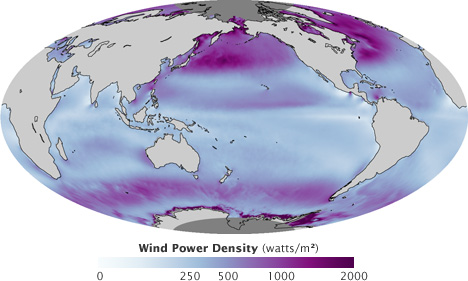
NASA scientists used satellite wind measurements to estimate the available wind energy over the ocean, called power density. Blue represents areas with little potential wind power, red indicates locations with high potential for power. To be cost-effective, offshore wind farms must be located near population centers in shallow waters with high power density. (NASA image created by Jesse Allen, using QuikSCAT data from Timothy Liu, Wenqing Tang, and Xiaosu Xie, NASA/JPL.)
“Eventually, we just tried QuikSCAT,” says Pimenta. He compared QuikSCAT measurements of wind speed to measurements taken at the same time by the one buoy that had been in operation during the QuikSCAT record. The two matched reasonably well—close enough, his professor told him, to do a first estimate of the power potential. He extrapolated QuikSCAT measurements of wind speeds at 10 meters above the surface of the ocean to wind speeds 80 to 100 meters up, the height of the wind turbine’s hub. He calculated the amount of power existing turbines would produce at those speeds, and then averaged these measurements to get an estimate of power production throughout the year. In the end, he came up with a map of turbine power output for a wide swath of coastal waters off southeast Brazil.

Pimenta compared measurements of wind speed measured by a buoy (blue line) with satellite data (purple dots) to confirm the accuracy of QuikSCAT. (Graph adapted from Pimenta et al., 2008.)
But knowing how much power the winds could provide was not enough to make a practical estimate of the wind potential of the area. Pimenta also had to know how many turbines could actually be built off the Brazilian coast. Wind farms can’t be built in shipping lanes or bird flyways or near scenic coastlines. Current turbine technology can’t be installed in waters deeper than 50 meters, though companies are beginning to invest in floating turbines. Pimenta superimposed the wind data onto a map of the ocean floor to identify suitable locations for wind farms. This allowed him to calculate how many turbines could be installed off the southeast coast of Brazil. If the suitable areas were fully developed with existing technology, Pimenta estimated that offshore wind farms could produce 102 gigawatts of power on average. Brazil’s average national power need in 2008 was about 100 gigawatts.
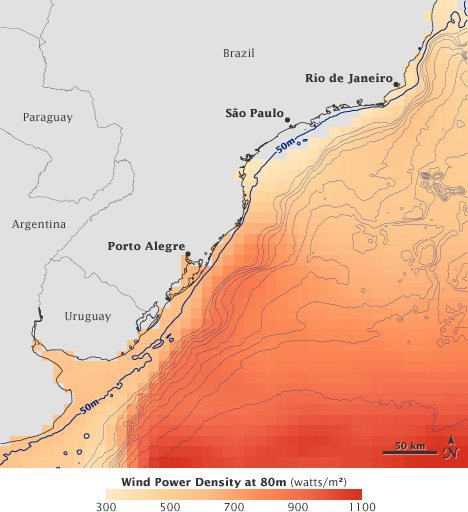
Current offshore wind turbines must be in water no more than 50 meters deep. Pimenta combined his estimates of wind power density at 80 meters above the surface with ocean depth measurements (blue lines) to find nearshore areas with high winds and shallow water. His analysis shows a promising location for a wind farm near the city of Porto Alegre, Brazil. (NASA map by Robert Simmon, based on data from Felipe Pimenta.)
After turning in his final project, Pimenta published his results in Renewable Energy in June 2008. No one has contacted him yet about developing an offshore wind farm in Brazil, but the possibility is real. It has happened to other students who have taken Kempton’s course. “A developer decided where to site a billion dollar plus project based on data that was produced in one of our classes,” says Kempton. “We have some very good students. I show them how to do it and let them go.”